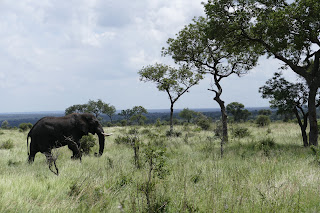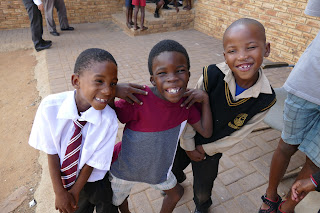 |
| The Kruger group |
This weekend was a long, holiday weekend for South Africa. Tuesday was actually Human Rights Day, so many South Africans take a long weekend in advance of the day off.
Our team was able to visit Kruger National Park, which is in eastern South Africa. Kruger is one of the largest game reserves in Africa, covering more than 7,500 miles. All Big Five wild animals can be found in the park, which includes: lions, elephants, leopards, buffalo and rhinos. The park is home to one of the largest elephant populations in Africa.
So, last Saturday morning, we boarded a bus headed to Kruger. We ended up driving to the park, which normally would take about four hours, but on African time (we have found things take much longer than expected here), it took us all day. We left around 8 a.m. and arrived close to 6 p.m. It was a long day of traveling - which meant, a long day of me lying down in the back of the bus, trying to sleep and recover as we made our way across the country.
About halfway through the trip, I realized I probably should have stayed at the hotel to recover. This was the same point in the drive when the roads went from being relatively smooth, to feeling like we were off-road driving down a rock and pothole filled highway. It was the bumpiest drive I have ever experienced. Forget sleeping at that point!
When we arrived at our accommodations, they were certainly well-worn. But we had air conditioning, which was much appreciated. I ended up in the guest house, with my teammate Dominika. We actually had our own individual rooms and bathrooms, which gave me a huge sigh of relief. I was not looking forward to sharing a room while I was battling the bacterial infection and thankfully, I didn’t have to. But we did have some rather aggressive monkeys try to squirm their way into our room - thankfully, we were able to shoo them away.
 |
| Trying to keep the rain out! |
After we dropped our baggage, we headed out on an evening game drive. Initially, we didn’t see anything but ant hills, birds, and antelope - not very exciting. But as we continued to our outside braai (South African BBQ), our driver found a family of giraffes, who walked right past our vehicle. We also came across a rather angry, black rhino. In fact, he stomped his feet and charged toward our jeep - in the direction of my friend Javier and me. The driver began shouting at the rhino and making noises, which persuaded him to stop and turn around, but he was still not happy with us. We didn’t see any lions that night, but did find a few more zebras, so it was fairly successful.
Sunday morning we set out for Kruger. We spent the entire day in the park. However, the weather took a turn and for most of the day we battled pretty strong winds and on and off downpours. The wind was actually preferred though, because it kept mosquitos away and the temperature down. Our jeep was open-air, but had plastic windows that hung down to protect us from the rain - except the windows and the ceiling both leaked, so we fairly soaked by the time the drive was over.
Kruger was beautiful though, despite the weather. We saw quite a few animals. In fact, Kruger has one of the largest populations of elephants in South Africa. We saw so many herds of elephants, including babies! We saw one elephant bathing himself in a fairly deep pool of water, another running to catch up to his herd, shouting through his trunk. We saw two elephants play-fighting with each other. So.many.elephants.
 |
| Lioness and her cub napping in the distance |
We also saw a large number of girrafes - they’re all over Kruger, along with antelope and zebras. We managed to see one female lion, but from quite a distance. She was sleeping in a dried-out river bank. I was able to zoom in closely with my camera to watch her as she slept. At one point, she stretched and turned over, to reveal she had a cub sleeping on her stomach. And on our way out of the park, we ran into a pack of baboons walking down the road.
We left Kruger just as the park was closing for the night and headed to a tree house camp. We expected to all be sleeping in the high in the trees that night, but it turned out the treehouses were more like shacks, with straw ceilings, no air conditioning and less than optimal conditions. . . . As a girl who fully admits she hates camping, this was my own personal nightmare. It got worse when a frog decided to join me in the bathroom. Thankfully, it was only one night.
Domi’s and my cabin was quite a long trek from the main area, where we had dinner and breakfast the next day. We had to follow a dimly lit path, that twisted and winded over bridges and rocks. We got lost on more than one occasion trying to find our way to and from our room and the main reception area. To spend as little time in our rooms as possible, a few of us congregated in the dining area, where I taught my international colleagues how to play a fairly aggressive card game, which my brother and college friends and I call “Egyptian Rat Screw.” Thankfully this helped pass that time, before Domi and I made our way back to our cabin.
 |
| A shot of Blyde River Canyon |
On Monday, we packed our bags and headed back to our hotel. On the way, we stopped at Blyde River Canyon, which was in a word: beautiful. We felt like we were standing on top of the world, looking out over a beautiful waterscape. After spending about 20 minutes exploring, we headed back to our van…when someone started shouting for a doctor. We found out, an elderly woman who had been walking on the rocks near the canyon had fallen and very clearly broken her leg. I did not envy her.
Our dive home was again, on African time and took what felt like forever. We finally reached out hotel about 5:30 p.m. at which point I went directly to bed, not to be seen again until later the next morning. My body needed rest - which is what I should have done all weekend, but I was glad to have had the opportunity to see Kruger and more of South Africa.
More photos below:
 |
| View from our morning Bush Walk |
 |
| One of the pesky monkeys trying to enter our room |
 |
| So many beautiful elephants in Kruger |
 |
| Saw quite a few giraffes |
 |
| A baboon eating seeds from the riverbed plants |

























